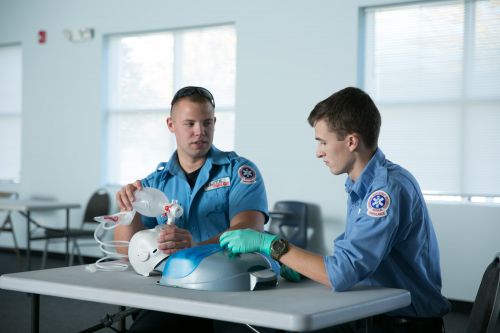When you call 911 for a medical emergency, an EMT or paramedic is usually the first to arrive. While it may seem that an EMT (emergency medical technician) and a paramedic do the same basic job, their roles differ.
While EMTs and paramedics are trained to help patients during transport to the hospital or other medical facility, paramedics have the training necessary to provide an advanced level of care. Discover other major differences and similarities between both roles.
The Role of an EMT Vs. a Paramedic
Paramedics and EMTs are part of the EMS (emergency medical service) team, which provides patients with basic and advanced medical care.
The primary difference between an EMT and a paramedic is their education and the specific procedures they can perform.
What Does an EMT Do?
An EMT handles basic medical procedures like administering CPR, glucose, or oxygen to a patient.
In a medical emergency, EMTs are called upon to assist. During transport, first responders examine patients to determine the nature and severity of their injuries. They communicate with the hospital, relaying important information about patient injuries, monitoring patient conditions, and caring for patients along the way.
Typically, EMTs are dispatched to the scene by a 911 operator and work alongside paramedics, firefighters, and police.
What Does a Paramedic Do?
Paramedics are highly-trained, licensed medical professionals who provide pre-hospital services to patients, such as advanced life support, before reaching the hospital.
They typically perform complex tasks like IV line insertion, administering drugs to the patient, applying pacemakers, and other advanced tasks.
Paramedics are more skilled than EMTs in providing emergency room-level care to treat acute injuries and illnesses. A paramedic has advanced training and extensive knowledge in cardiology, physiology, administering medication, and performing medical procedures.
Where Do EMTs and Paramedics Work?
EMTs typically work for a private ambulance service, the government, a hospital, a fire department, or a police department. They typically work under a physician or medical director’s supervision.
On the other hand, a paramedic may work for an ambulance or fire service with a group of EMTs. Paramedics also often work in medical air transport, where helicopters and aircraft transport patients.

The Responsibilities of EMTs vs. Paramedics
Although there can be some overlap, the responsibilities of an EMT are quite different from those of a paramedic.
Responsibilities of an EMT
- 911 medical emergency response
- The safe transport of patients from facility to facility
- Stabilizing and treating patients being transported to the hospital
- Assessing patients
- Communicating with the hospital regarding important patient information, such as the extent of the illnesses or injuries, patient count, and estimated arrival time.
- Maintenance of patient records
- The use of backboards or restraints for safe patient transport
- Administering of CPR (cardiopulmonary resuscitation)
- The treatment of wounds
- Shock and injury prevention
Responsibilities of a Paramedic
- The stabilization of a patient for safe medical transport
- The treatment of severe wounds and prevention of blood loss
- Emergency baby delivery
- The prioritization of medical care at accident sites to ensure severely injured victims receive immediate attention
- Performing tracheostomies or other procedures to open the airway of patients with breathing issues
- Administering medication through IV (intravenous) injections or infusions
- Decompressing collapsed lungs by sticking needles into a patient’s chest
- Maintenance of patient records
- Applying pacemakers for controlling heart arrhythmias
- Administering life support through ventilation devices or breathing tubes
Education Required to Be an EMT vs. Paramedic
One of the biggest differences between EMTs and paramedics is the amount of training they need to go through to get certified. While EMTs complete their course after 150 hours, paramedic courses are 1000-2000 hours long.
Typically, paramedics start as EMTs, gaining one to two years of job experience. Then they begin their advanced education.
You can start an EMT course with a high school diploma or GED. Once you complete the 150 hours of training, you must pass the NREMT (National Registry of Emergency Medical Technicians) cognitive exam.
Before starting paramedic training, you must complete basic and advanced EMT training, then undergo a two-year college-level degree. After this course, you must take the NPC (National Paramedic Certification) exam and any state-required licensing exams to be certified as a paramedic.
It may seem like a long road to becoming a paramedic, but it’s definitely worth it.
Certifications and Licenses for EMTs
Most EMT programs require CPR training and certification before you begin. The American Heart Association and American Red Cross provide CPR training and certification.
You must be 18 or older and possess a valid state-issued driver’s license to receive an EMT license. You must also obtain National Registry Emergency Medical Technicians (NREMT) certification. Most states will need it to certify you as a licensed EMT.
EMTs must renew their EMT certification in two-year cycles. Recertification involves either taking the cognitive exam or continuing education. The NCCP (National Continued Competency Program) requires 40 hours of continued education for recertification.
Certifications and Licenses for Paramedics
A licensed paramedic must also be 18, have a high school diploma, CPR certification, and a valid state-issued driver’s license.
Once graduating from an approved paramedic program, you must become certified through NREMT. However, the NREMT certification doesn’t guarantee practice.
A paramedic must possess a state license for practice in a particular state. Some states will grant licenses based on NREMT certification. Others administer their own licensing tests.
Paramedics must also renew certification in two-year cycles by taking the exam or continuing education. NCCP (Paramedic National Continued Competency Program) requires 60 hours of continued education for recertification.

EMT vs. Paramedic Salary
According to Payscale, EMTs in the U.S. earn an average annual salary of $30,500. Paramedics earn an average annual salary of $46,500.
EMT vs. Paramedic: Which is Better?
The truth is, both EMT and paramedic positions offer unique opportunities.
EMTs have fewer responsibilities and limited duties. You need less training to start working as an EMT, but the salary is also lower.
Paramedics need a lot of training, but they’re also responsible for advanced emergency care, including advanced life support services, to patients. And they’re better compensated for that too.
Yet, both jobs are rooted in a desire to help others by working in the medical field. And that means that both are on the frontlines of EMS.
Whether you want to become a paramedic or an EMT, you need to get your EMT-B certification. Completing this training is a prerequisite for further studies that lead you to a paramedic career.
For some, EMT is a stepping stone to becoming a paramedic. For others, being an EMT is their calling. And both positions are incredibly valuable when it comes to saving lives.
Become an EMT or Paramedic in Chicago
As a part of EMS, your work will always make a difference. But before you begin saving lives, you need to get certified.
If you’re in Chicago and you want to become an EMT or a paramedic, start your career with Elite Ambulance.
Our courses offer all the theoretical knowledge, practical skills, and professional insights you need to get started in the field. As a bonus, you get an immediate job placement after graduation!
Start your career of saving lives by joining Elite Ambulance’s EMT academy, or continue your education on our paramedic course!
Comments are closed.



Recent Comments